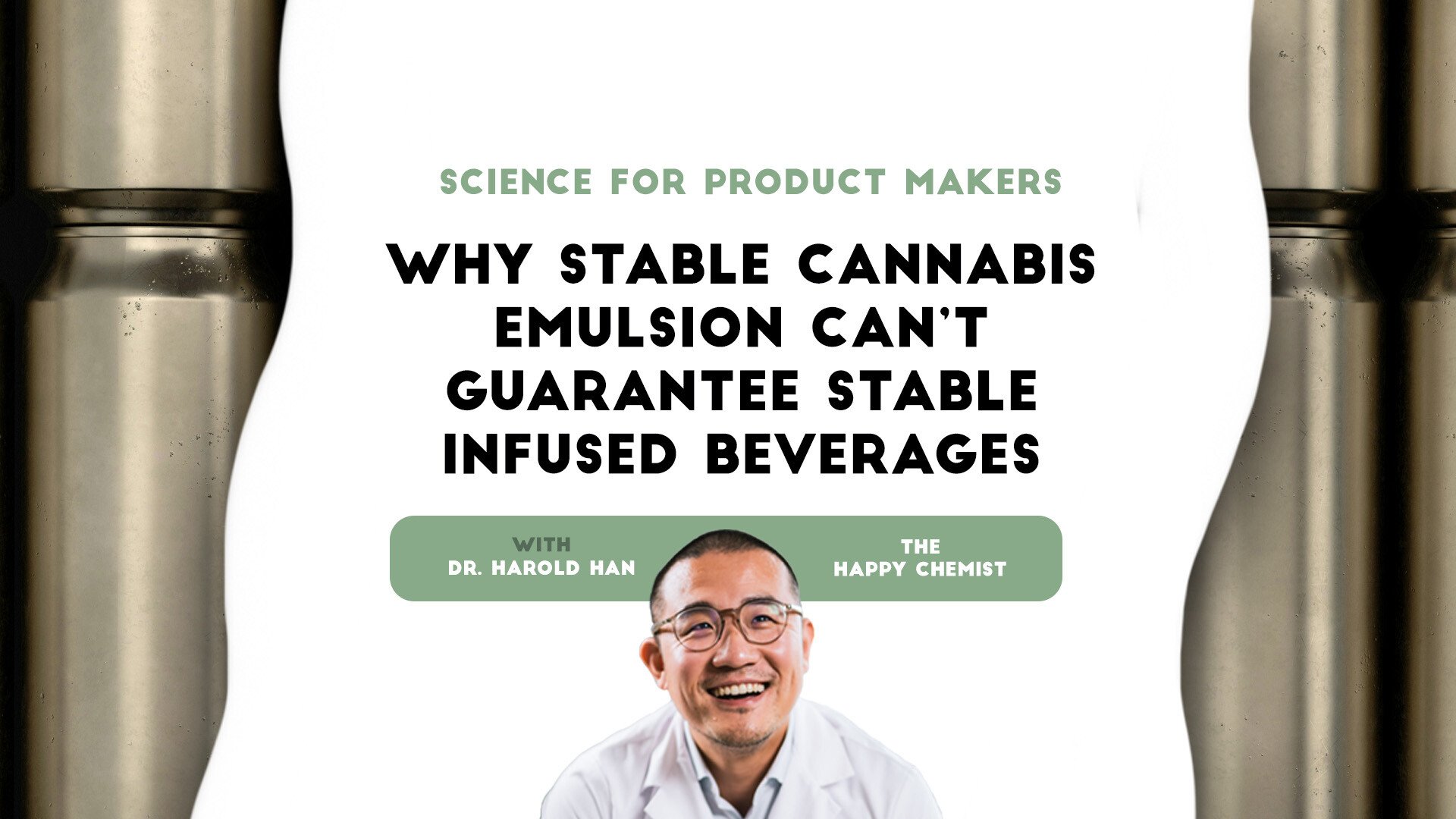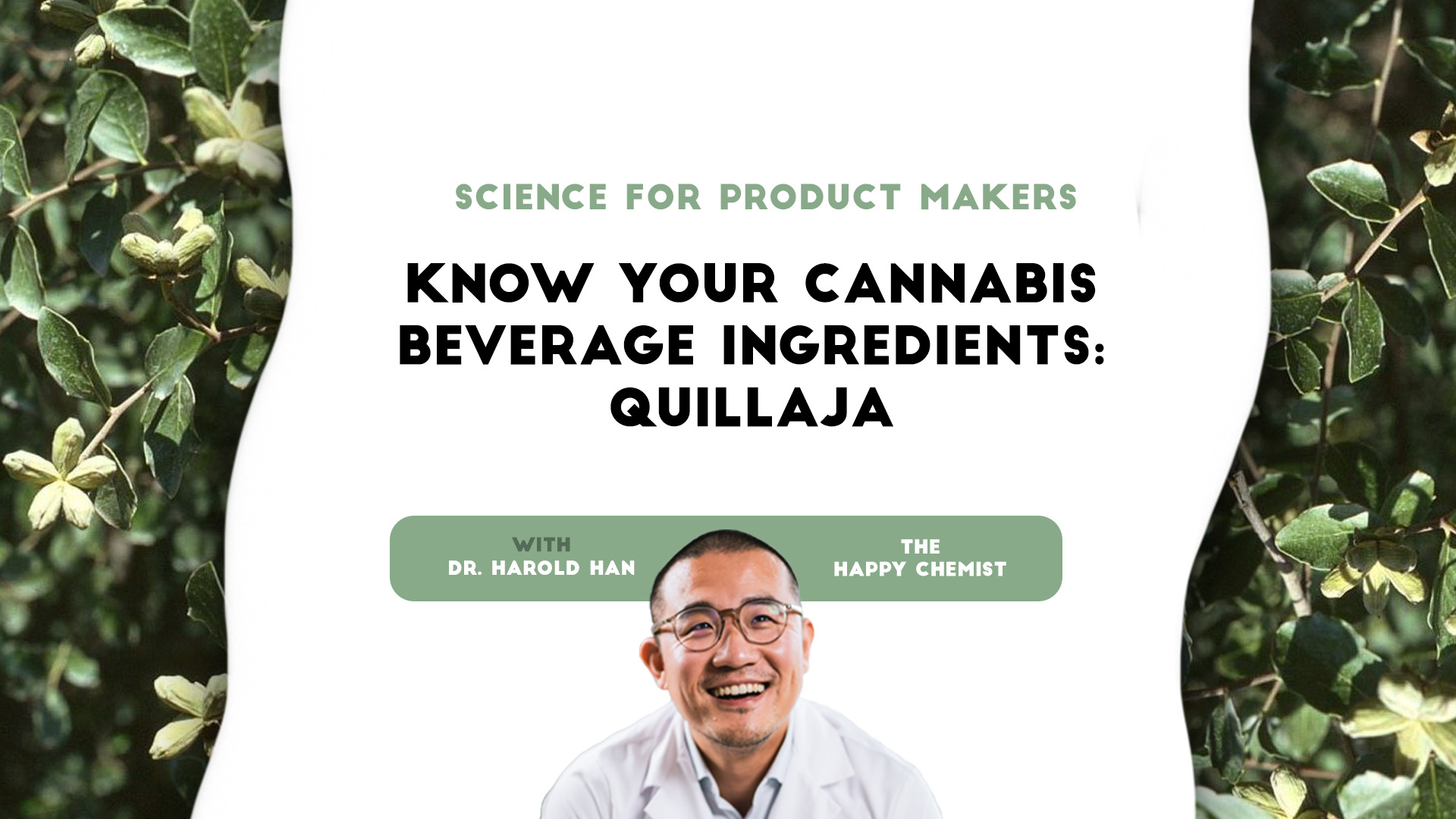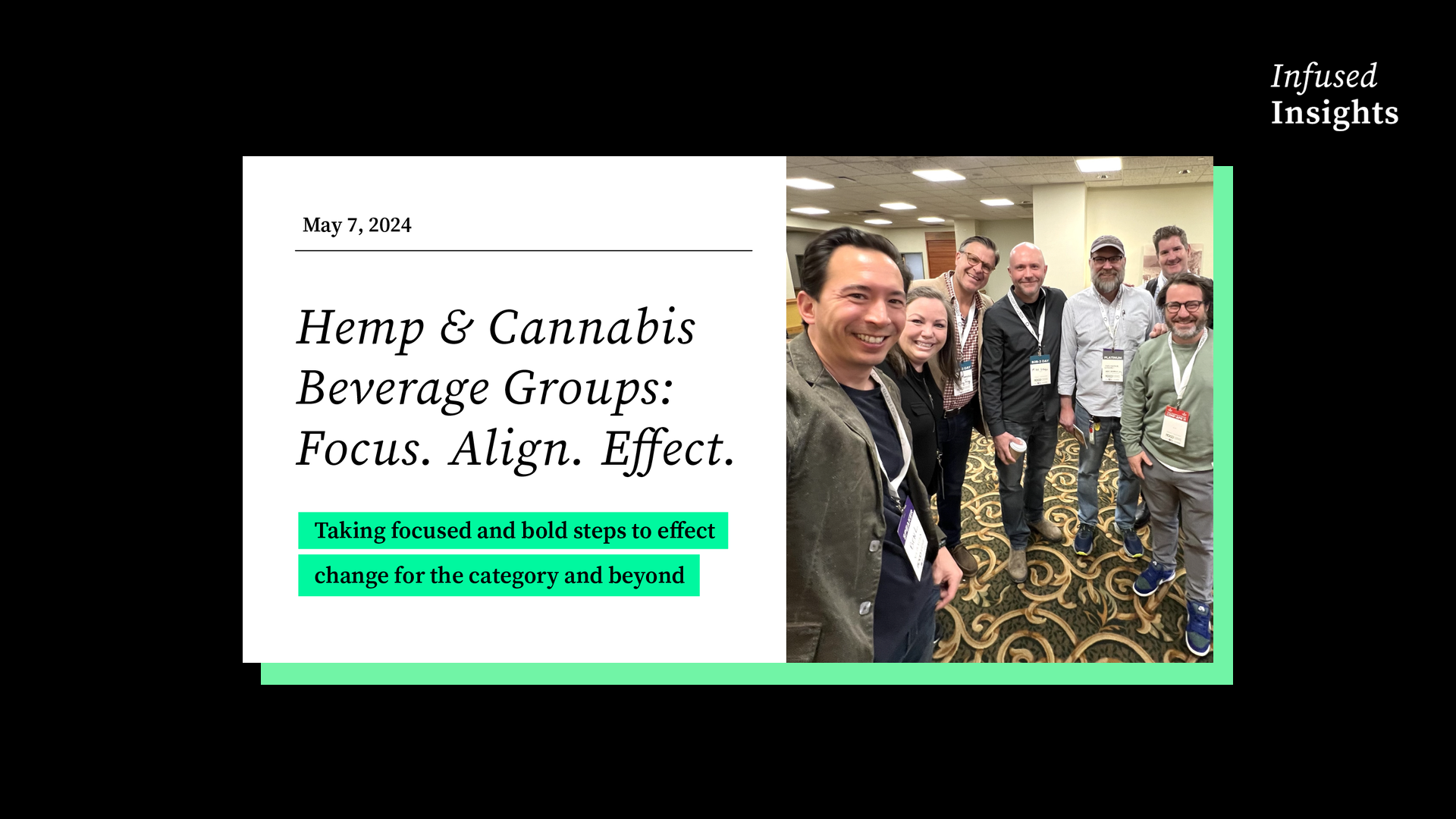Vertosa Emulsions Reduce Potency Loss in Aluminum Cans
Have you ever thought about what’s in that aluminum can you’re drinking out of? Well, other than the calories or sugar content of your beverage of...
6 min read
 Dr. Harold Han - "The Happy Chemist"
:
6/29/24 9:29 PM
Dr. Harold Han - "The Happy Chemist"
:
6/29/24 9:29 PM

Last week I asked my followers what they think is the most important factor for cannabis beverage potency stability. Most people selected “infusion tech”.

Potency stability is taking center stage in the cannabis beverage industry because it helps gain consumers' trust, especially as a new product category. And while quality cannabis emulsion is critical to stable potency, it’s far from the only factor. Many cannabis beverage brands want potency stability but might not have the time or resources to focus on all the details in the supply chain that can affect potency, which can be quite overwhelming.
Today, I'll explain why high-quality cannabis emulsion isn't the only crucial factor and what other details cannabis beverage brands should pay attention to.
Cannabis infused beverages are a rapidly emerging product category that are showing great potential when it comes to mainstream acceptance. Unlike traditional alcoholic beverages, which have well-established manufacturing processes and clear regulations, cannabis-infused beverages have a unique supply chain that needs to establish new standards.
There are seven key parts of the supply chain for making cannabis beverages: 1) cannabis input, 2) infusion technology, 3) beverage formulation, 4) packaging type, 5) beverage manufacturer, 6) testing lab, and 7) distribution & retail. These parts are connected and each play a role in ensuring the quality of the final product, especially when it comes to maintaining consistent potency.

When exposed to oxygen, most cannabinoids oxidize, but they do so at different rates. From an in-house study conducted at Vertosa, we found that cannabinoids' oxidation rates in beverage format can be grouped into three categories:
So, with all other factors being equal, a CBD beverage would probably have a longer shelf life compared to a THC beverage because CBD oxidizes more slowly.
There are two main considerations when evaluating infusion tech: shelf-stability and stability in the finished product. Infusion tech’s shelf-stability includes stress tests on heat, gravity and degradation over shelf life. However, when infused into a beverage, its stability can be impacted by ingredient compatibility, scalping rate and oxygen-induced degradation.
For a long time, beverage formulations haven't received enough attention when considering potency stability. Brands often assume that a good-tasting base from a flavor house should be stable, and they just need to add emulsion to complete the recipe. However, the main focus of flavor houses is on taste, not ensuring beverage stability. For instance, a flavor house might use natural puree and create a formula with heavy sediment, but those sediments can bind with the cannabis emulsion and lead to uneven potency distribution. Special care is needed to produce infused beverages with heavy sediments.
At Vertosa, we look at this issue from two perspectives: ingredient compatibility at the macro-level and accelerated scalping at the micro-level.
Ingredient compatibility tests are complementary for all new SKUs infused by Vertosa. Its main goal is to confirm that the cannabis emulsion does not have negative physical interactions with the beverage base. For example, we have observed that certain emulsions are not compatible with beverages containing high levels of polyphenol. The two ingredients bind with each other and settle to the bottom, causing major issues in potency homogeneity. The compatibility study is to avoid catastrophic failure like this.
Passing the compatibility study, however, does not guarantee potency will remain stable in the final beverage. We’ve started to see beverage base formulation impact scalping rates. Even within the same brand, some SKUs could induce a higher scalping rate which causes potency to drop faster. Sometimes the main difference is just the flavor component. As cannabis beverages proliferate into the mainstream, many innovative ingredients will come into play: proteins, vitamins, amino acids, polyphenols, electrolytes, natural sweeteners and dyes. When these ingredients come into contact with cannabis emulsion, the unique chemical environment could stir up unpredictable interactions that present themselves through potency instability. This is a new phenomenon and definitely deserves more attention in future research. Currently, I think it is a good idea for brands to connect infusion partners with flavor houses early in the formulation stage. Additionally, I highly recommend performing a pilot production run before going into full production. This is the most effective way to prove the stability between formulations and infusion tech.
Packaging type can be a huge factor for the long term stability of infused beverages. It mainly impacts potency stability in two ways: physical scalping and chemical oxidation from oxygen ingress.
Scalping is not a foreign concept to the cannabis beverage community. Over the years, we have tested many different can liners to understand the scalping rate between liner chemistry and emulsion chemistry. It is generally believed that a well designed emulsion can be stable with a variety of liner types. But this isn’t guaranteed for all liners. Some liners provide inadequate potency stability and I believe the community has been well educated on this topic. Here is a list of packaging that we validated to have less scalping issues.
Oxygen ingress, however, is not a topic often discussed in the industry, but it plays an important role in determining potency stability. It is common knowledge that plastics allow more oxygen permeability than glass and cans, but beverage makers should also consider how oxygen ingresses through child-resistant caps and sessionable can ends. If oxygen is able to constantly ingress through packaging, oxidation will continue to be a challenge for maintaining potency stability.
Don’t forget to consider the age of the can! Generally, beverage makers should avoid cans that are over 2 years old due to the degradation of liner quality. The production date usually can be interpreted from the code on the side of the can. If you have questions about this, you can reach out to me for more information.
The beverage manufacturer is the essential part of the supply chain. They assemble all ingredients into the final product, where the equipment, the team, and the operation protocol all contribute to the overall quality of the products. Each of these operational processes impact product potency: accuracy of weighing each ingredient, method of introducing each ingredient, dissolved oxygen control, pasteurization condition, overdose percentages, and R&D potency testing before filling.
Quality protocol and staff training is also very important. Do they have a Quality Management System (QMS) where all ingredients / procedures / batch records can be tracked and traced? Do they have a quality team to ensure products meet spec before leaving the facility? These are valuable questions to ask when evaluating a beverage co-manufacturer.
The manufacturer's quality not only affects the initial potency accuracy but also influences the long-term shelf life of the product. Put simply, if we compare two identical products—one made with 1000 ppb Dissolved Oxygen and the other with 100 ppb Dissolved Oxygen—their potency and shelf stability will differ significantly.
In one of my previous articles I discussed why it’s still challenging to ensure all testing labs deliver the same accurate result consistently. Lack of “Certified Reference Materials” and standardized sample preparation methods, coupled with different levels of staff training and instrument maintenance, all contribute to variations amongst labs. In addition, we started to notice that HPLC sample preparation methods can dramatically impact potency results, especially when certain beverage ingredients are used. Should an infused coffee with cream have a different preparation method than a high protein / prebiotic beverage? We need to keep developing new testing methods to support more innovations in this space. It is also important to point out that the ideal lab partner should operate with integrity without pandering to potency inflation requests.
If you've made it to this stage and have accounted for the previous steps, it’s likely your beverage is probably pretty stable. However, it’s important to note that the greatest risk during distribution and retail is the storage conditions (ex: temperature, humidity, and UV exposure). In the Canadian and Michigan regulated markets, accelerated beverage shelf life studies are performed at 40°C. When you consider that 40°C (or even higher temperatures) may be normal conditions in certain warehouses or trucks, it’s easy to see how the storage condition and duration of those conditions will affect how quickly the potency of the cannabis beverage degrades.
Imagine placing a high-quality THC emulsion into a beverage base with a high concentration of electrolytes at a very low pH, or using a can liner which is not compatible with cannabis emulsion, or producing with high levels of dissolved oxygen; those products would have long term potency issues. What if you also test it in a lab that doesn't use the correct methods, or your retail stores the final product in a warehouse with high temperatures? A failure during any of these stages could result in failure of the finished products’ intended stability.
I hope you can now see that to make a successful infused beverage, a product maker needs to pay attention to details in each step of the supply chain. A good cannabis emulsion is essential, but it is not the end-all-be-all for potency stability in cannabis beverages. Were you aware of all these potential pitfalls? Let me know in the comments if you learned something new! Is there something else we should all be considering?
Dr. Harold Han — the “Happy Chemist” — combines his storied background in emulsion chemistry and science with curiosity and fascination in the rapidly growing cannabis industry. Developing nano and micro emulsions his entire career, Harold holds a Ph.D in Surface Chemistry from NYU and is the holder of multiple patents for his inventions in emulsion chemistry.
As the Chief Science Officer at Vertosa, Harold spearheads the company’s development of industry-leading and customized active ingredients for infused product makers, offering pre-suspended aqueous solutions to create incredibly homogenous and stable products while maximizing bioavailability, clarity, and taste.
To learn more about the science of cannabis, make sure to follow Harold on LinkedIn and check out his Happy Chemist videos.
.jpg)
Have you ever thought about what’s in that aluminum can you’re drinking out of? Well, other than the calories or sugar content of your beverage of...

This post is also published as an article on Harold's LinkedIn profile. You can read and leave comments here.

This post originally appeared on Ben's LinkedIn Newsletter, Infused Insights. You can read and leave comments here. {% video_player "embed_player"...